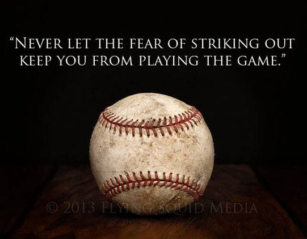“No thanks, we’ve decided to stick with our current vendor.”
Such words are never easy for a sales rep to hear. Despite your hours of preparation, proposals, and in-person meetings, the prospect decided your solution wasn’t the right fit. Was it something you said? Could you have done something differently? How did you not see this coming?
Stop beating yourself up and face a simple fact: We all strike out once in awhile.
My goal with this post is to make you feel a little better about your recent strikeout. So, let’s explore the many similarities between two of my favorite things: baseball and sales.
Failure is More Common than Success
In today’s busy world, it’s hard to find three hours to watch an entire baseball game. Granted, DVR technology can help speed things up. Even then, I usually fall asleep before the last pitch is thrown. When this happens, I’ll typically watch the highlight reel the next day.
Highlight reels are great – they allow us to know what happened in much less time. However, they also present a false sense of reality – home run, triple, exciting play at the plate, more home runs. Highlight reels only show, well, the highlights. By necessity, they cut out at least 90% of the rest of the game. What gets cut out? Boring things like:
- Foul outs
- Balks
- Pickoffs
- Ground outs
- Pop ups
- Errors
- Passed balls
- Failed bunting attempts
- …and, of course, strikeouts
In retrospect, these events seem forgettable to the average fan (which is why they don’t make the highlight reel). Yet, in reality, they account for most of the action. They also tell us an important fact about baseball: failure is more common than success.
Take batting average for instance. What is a “good” batting average? In the big leagues, very few players are able to maintain an average above .300. In fact, Ted Williams, arguably the greatest hitter of all time, was the last person to hit above .400 for an entire season (during the 1941 season).
In other words, today’s best baseball players get out seven out of ten times. And, the best batter of all time, was only marginally better than that (six out of ten).
It’s clear to see how success in the batter’s box relates to what you do in sales. If you call ten cold leads, you might be ecstatic if three bought from you. Like your baseball brethren, you’re accustomed to dealing with failure. It just makes your next “hit” even sweeter!
Not Every Hit is a Home Run
Swinging for the fences can get you into trouble. Sure, you might get lucky and occasionally hit one into the upper deck. You’ll probably also experience more strikeouts in the process. Smart hitters know when to adjust their approach, choke up, and settle for a hard-hit single or double.
Likewise, your pipeline always has a few potential “home runs” waiting for you to close. That six-figure contract you’ve been working on is the perfect example. If you close that deal, your quota will be looking good for months.
Being the sales professional that you are, you know better than to focus only on big deals. It would be nice if they happen, but there are many factors outside of your control. You can’t force big deals through, just like baseball players can’t force themselves to hit home runs.
So, how do you “choke up” and improve your batting average? For starters, you need a way to size up deals. A CRM, such as Insightly, can be a valuable resource for doing exactly that. Insightly makes it easier for you to tell a potential single from a grand slam. When adding an opportunity, Insightly prompts you to specify the deal’s potential value:

Using Insightly’s opportunity report builder, you can then filter deals based on revenue potential. Need a few quick infield hits? Set your filter, identify your targets, and hustle down the first base line.

Slumps Happen (& Pressing Doesn’t Help)
Even Ted Williams went through slumps. All baseball players do – batters and pitchers alike. Unfortunately, there’s no magic cure for a slump. A batter can’t make the ball drop in between two fielders. A pitcher can’t snap a losing streak simply by willing it.
Although slumps are hard to shake, there’s one thing that makes them even worse: pressing too hard. Now, I’m certainly no Ted Williams, but I’ve played in my fair share of baseball games. During that time, I’ve endured slumps that seemed to never end. Going twenty at-bats without a hit certainly makes you question your abilities. Why are my teammates still getting hits? What am I doing wrong? Do I need to practice harder? Is coach going to sit me on the bench if I don’t get things going?
A slump is certainly a humbling experience. It’s also a test of your self-confidence. Worrying yourself silly doesn’t help matters; it only makes things worse.
In sales, you’ve probably gone through several dry patches. For whatever reason, you can’t seem to move the needle. You feel like nothing has changed, but clearly the results show otherwise. When is it time to worry?
Most slumps are caused by nothing more than the law of averages. Ditto for when you’re knocking it out of the park. Good times and bad times tend to average each other out. Just remember that the next time you go on an “o-fer” streak.
It’s a Team Sport
At the peak of my career, I could only get my fastball into the mid-80s. But, for the sake of conversation (and my ego), let’s imagine my fastball hovered around 102 mph. Let’s also imagine that my splitter, slider, and changeup were virtually unhittable.
Even with such a lethal pitch arsenal, it would be impossible for me to single-handedly impact my win-loss record. Throwing a perfect game is pointless unless your team provides run support. It’s a team sport.
The same is true in what you do. Being a superstar deal closer is great, but you also need a superstar team to deliver on the promises you’ve made. You may not have control over hiring decisions, but you can choose where you work. If management doesn’t have your back, then perhaps it’s time to take your talents elsewhere. If they do, you still need a way to hold others accountable. Connecting the sales and delivery functions is a step in the right direction. Insightly can help you do that.
Since Insightly is an all-in-one CRM and project management tool, the transition from sales to delivery is completely seamless. The moment a deal closes, the opportunity can be immediately converted into a new project.

As you stride confidently to the locker room, you can rest easy knowing the team has everything necessary to deliver. All emails, notes, files, and links are preserved, providing a 360-degree view of your valiant effort. “Now go out there and get me some run support,” you think to yourself.
You Need the Right Equipment
Obviously, a hitter must have a bat in hand before stepping up to the plate. What’s less obvious are the many factors involved with choosing the perfect bat.
- Ash or maple?
- Large or small grain?
- Painted or natural finish?
- Cupped end or rounded?
- Long or short?
- Heavy or light?
- Pine tar or no pine tar?
- Gripped handle or not?
- Well-known or lesser-known brand
With limitless combinations, how do batters choose the right bat? Some rely on recommendations from other players. Others do plenty of research, scouring the web for just the right fit. Still others order several different makes and models, testing each in batting practice before making a final decision.
Much like a batter, your company has countless options when it comes to “equipment.” CRMs are no exception to the rule. With dozens of cloud-based platforms to choose from, how can you help your team pick the right CRM software?
Take a page out of the batter’s playbook and start by asking colleagues for suggestions. What do they like / dislike about their current CRMs? Which CRMs have they tried but abandoned? Which features are must-haves? Have they noticed an uptick in “home runs” since implementation?
It’s also wise to do your own homework. What are people saying online? Read plenty of real reviews from real users (check out some of Insightly’s ratings here) and drill down into specific pros and cons. No solution is perfect, but some CRMs definitely stack up better than others.
After building your shortlist, take advantage of free trial offers before making a CRM buying decision. (If one of your shortlisted tools does not offer a free trial, you might want to reconsider it. What are they hiding?)
The Diamond Awaits
I hope this article has, in some small way, softened the impact of your recent strikeout. Stop worrying about it! Let it go! Trust your skills and turn your attention to the next at bat, the next pitch, and the next big play. Your team is counting on you – you can do it!

Matt Keener is a marketing consultant and President of Keener Marketing Solutions, LLC. Matt specializes in content marketing and strategic planning, having helped numerous Saas (software as a service) companies and other small businesses worldwide. Read more of Matt’s work, get his book, or connect on LinkedIn.








